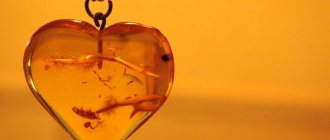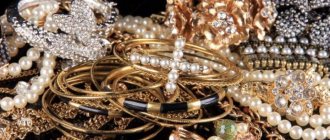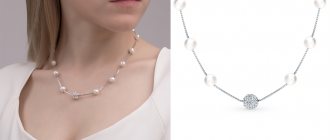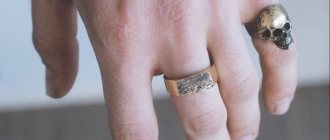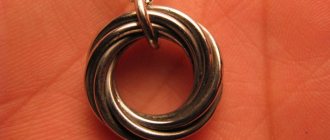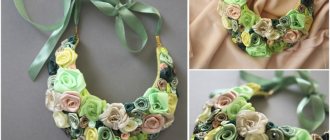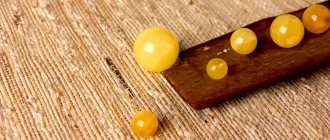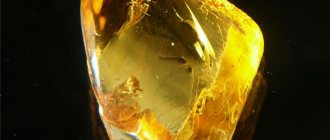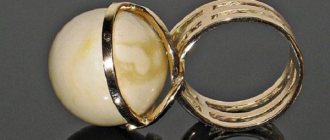At any time, amber, which is a valuable resin from ancient coniferous trees, has been tried to be counterfeited in different ways: sometimes just out of interest. But more often people were driven by the desire to compete with nature in the mastery of beauty and unusualness. Ultimately, this resulted in mass fakes of amber, which are sold everywhere and very successfully - often due to reduced prices for products made from completely different materials. Of these, we will consider the most popular, the origin of which can be either natural or artificial.
dug
By its nature, it is in many ways reminiscent of amber, because it is a hardened tree resin, but the resin of amber comes from conifers, and not from leguminous plants. In addition, amber has existed for millions of years, and copal hardly exceeds the “age” of only 1000.
Externally, copal can be impossible to distinguish from amber, especially from some of its varieties. Autoclaving using various chemicals increases the density and hardness of the legume resin. One of the most common ways to attract buyers is the “art” of introducing some insect into a liquid resinous drop, and then saying that this is the work of nature itself.
Fill
So, the resin has thickened, the petals are laid out on a surface covered with tape, and we begin to create. We take our fighting stick, dip the tip in resin and apply a drop to the petal.
In principle, you can smear it over it, holding the leaf with your finger (with latex gloves so that there are no greasy marks left), but it spreads quite well on its own. Here you will check how level your table is. Having covered all the prepared petals with the first layer of resin, cover our miracle tray with a lid and leave it all for 24 hours. Then we apply another layer of resin (for now both layers are on the front part).
After a day, we turn the petals over and apply the last layer, but on the back sides of our products.
Cowrie resin
It is distinguished by trees with the same name, which are a type of conifer. They secrete resin abundantly if the root system is severely damaged. Sometimes the resin weight can be half a ton or even more. However, its chemical composition resembles amber only approximately. The same applies to the physical characteristics of cowrie resin. These trees are also copal trees. Their resin is used in the production of high-quality varnishes, and only some “manufacturers” are engaged in counterfeiting it as amber.
In Auckland, New Zealand, there is a museum in which a huge room is dedicated to kauri trees. As ordinary people say, the resin of this tree is completely impossible to distinguish from amber in appearance.
Bernit
Bernite may contain a small percentage of amber substance - about 5%. Large jewelry companies have long abandoned the imitation of amber using it. The artificial bernite stone itself is often painted in different colors and sold as an independent product, which is in good demand. However, those polyester compounds that are present in bernite can “pass” well as transparent honey amber. Defects are still artificially created in bernite, making it difficult to distinguish it from amber with the naked eye.
Initially, the production of bernites looked like this: amber powder was mixed (sintered) with polyester resin. Under conditions of the process occurring in an oxygen environment, the color of the stone turned out to be yellowish with a red tint, and if it was heated in a nitrogen environment, it turned green. Today, the range of bernite products is very wide, with virtually the entire color range available. It may also happen that prices for amber will rise significantly, which means that the number of fakes made of burnite will also increase.
Method one
Let's prepare turpentine resin, rosin, shellac in a ratio of 1:1:2. Let's take a tin vessel, grease the walls with oil, and melt turpentine in it. As the material melts, we add shellac to it, and the consistency of the mixture will become thicker and take on a white tint. After this, you should heat it until it becomes transparent. As soon as this happens, pour pre-melted rosin into the mass in small portions. Gradually, when heated, the mass will become even more transparent; the desired color can be obtained by choosing the appropriate shellac. Please note: the longer the mixture is heated, the more intense and darker the color will be. By the way, stone prepared under such conditions will have a harder texture. If you want a softer consistency, you need to add a little more turpentine.
The resulting fake amber can be cast or shaped by pressing. The stone can then be polished and ground. It must be remembered that this composition is not sensitive to water, but can dissolve in alcohol.
Polyburn
This is an artificial stone that was created in Soviet times in the GDR from amber chips held together with epoxy (polyester) resin. It was she who gave the small pieces of amber bright colors, which were approved by the leadership of the German Communist Party. In a short time, polyburn production became widespread. The name of the stone itself comes from the names of its two components: “bern” was taken from “bernstein” (amber), and “poly” are the first letters denoting the name of the resin that held the amber pieces together.
During the era of intensive production of Polyburn, many decorations with inserts from this material were produced, as well as interesting interior items. But very soon polyburne went out of fashion, because its quality directly depended on what fragments of amber went into production. Therefore, it has become impossible to produce products with a stable guarantee of the same quality.
Despite this, the technology has not completely sunk into oblivion: even now in the Eastern part of Germany and in some Western European countries there are laboratories and enterprises producing small batches of polyburn.
Bakelite
This artificial stone was invented by the American chemist Leo Backland: he treated phenol with formaldehyde, and the world's first synthetic plastic was obtained. Backland himself did this experiment simply out of curiosity and not at all so that the material he created would be used to make amber fakes. However, fate decreed otherwise.
Initially, bakelite plastic became widespread in the manufacture of spare parts for various devices, as well as their housings - in the field of mechanical engineering and electrical engineering. Bakelite was successfully used to produce brake pads, adhesives and construction varnish.
In Germany, bakelite, along with polyburnum, found its use in the manufacture of jewelry “like amber.” The invention of Bakelite happened just at the time when the First World War ended. People did not have the financial ability to buy expensive jewelry made from natural stones. That is why the synthesis of “analogs” from plastic has become so widespread.
Phenol-formaldehyde resin itself has no color, but if you introduce some impurities into it and apply simple processing technologies to it, it acquires a beautiful, amber-yellow color. Thus, the markets of all European countries were soon filled with bakelite products “under amber”. By the way, a famous one has adopted this technology. Now the company actively uses bakelite in the manufacture of its famous pens.
Scope of application
Simbirtsit is of great importance in jewelry, decorative and applied arts:
- A wide range of vases, table tops, and small plastic items are made from the mineral. It is also a popular material for interior decoration.
- Due to the peculiarities of its texture and color, the stone is considered neutral. It is used to make a variety of products for men and women. These could be rings, earrings, cufflinks, brooches, tie clips.
The type of mineral is of particular importance in the decorative sphere. Ammonites require minimal processing, but vein ones require significant processing. However, in the end both gems look great. Simbircite is also a favorite stone of collectors. Its various fragments can be collected throughout life ad infinitum.
It is better to purchase collectibles and jewelry made from simbircite in Ulyanovsk. You can also find a large assortment of stone on the Internet. Keep in mind that it is also obtained from Ulyanovsk.
Faturan
This material was invented a long time ago and deserves some respect. It was created in the 17th century, when Eastern craftsmen processed amber dust and shavings, mixed them with resins of various origins, and then heated and pressed them. This is how faturan turned out. Products made from faturan are distinguished by their amazing beauty: their color is honey-red with a wonderful matte tint. Unfortunately, the production technology was lost, and it is no longer possible to restore the original methods of producing faturan.
But when Bakelite became a powerful commercial success in Europe, a certain Dr. Thrawn from Hamburg modified it in ingenious ways, giving it a resemblance to faturan. Thrawn simply tinted the stone, and the fraudulent plan was a success. Thrawn's company was actively engaged in the manufacture of faturan counterfeits until the early forties of the last century and supplied them to the East. Modern “craftsmen” are still engaged in this fraud, counterfeiting both amber and faturan by mixing who knows what synthetic materials.
Celluloid
It was invented in America in the second half of the 19th century. Celluloid was patented by John Wesley Hite. Initially, its goal was to imitate natural ivory, but later, from nitrate cellulose, camphor and colloidal paints, it was possible to obtain a product that could be successfully passed off as amber.
Celluloid, made to look like amber, was used as decorative finishes on tableware. It is produced in the form of plates, the texture of which is very similar to amber. But it gives itself away as too bright, “screaming” colors, which indicate its artificial origin.
An interesting fact is that celluloid is now produced in very limited quantities due to the flammability and unsafety of this material. It is not so easy to see celluloid fakes of amber in retail sale.
Casein
At its core, it is one of the milk proteins. At the beginning of the twentieth century, they tried to process casein with formaldehyde, which resulted in a resin that was actively used in industrial production. In the USSR, this material began to be called galalite, having been received from the Germans as a ready-made product.
In the production of casein (galalith), technologies were used that allowed for a variety of products. A certain amount of hydroxyl group substances was integrated into the molecules of the artificial material. The result was a yellowish stone, as well as a red-brown one, which did not transmit light at all. Additives from coloring substances helped in creating a material similar to various natural stones, not just amber. Galalite was counterfeited to resemble mother-of-pearl and ivory. They even made piano keys from it.
If you look closely at galalite, it is much heavier than natural amber. Its thermal conductivity is much greater, and galalite is cooler to the touch than amber. In the USSR, galalite was discontinued more than half a century ago. At the moment, its manufacturing technologies are used in small private workshops.
How to spot a fake at home
Within the walls of the store they will not be allowed to apply the method of destructive testing to the product, but at home you can try some actions. The simplest and most accessible methods for detecting counterfeiting are:
- try to scratch the product with a knife;
- place the sample in salt water;
- electrification;
- melting;
- using chemical reagents;
- exposure to ultraviolet radiation.
An attempt to scratch a natural sample with a knife should result in a scratch on the surface, along the edges of which small fragments will appear. The plastic product will have solid shavings.
Fragments of real amber will float in salt water, and sink in fresh water. This is due to the physical properties of the stone, the density value is 1.05 g/cm3, while the salt solution has a density of 1.19 g/cm3. To prepare the solution you will need 10 teaspoons of salt and 250 g of water.
As a result of the test, samples made of glass, fresh resin and bernite will sink, while pressed amber (ambroid) and copal will float on the surface of the water.
A simple way to check is related to the property of electrification.
If you rub an amber product on wool and immediately apply a sheet of paper to it, the paper will magnetize it to it.
If you rub amber intensively between your palms or on textiles, it will heat up and begin to emit the aroma of pine or turpentine. Artificial fragments will begin to smell unpleasantly of chemicals.
An identical effect is observed if you touch the surface of amber with a hot needle. A rosin aroma and thick white smoke will appear. If it is fake, there will be a distinct smell of chemicals.
The natural material is resistant to short-term exposure to alcohol or solvent. The plastic imitation will begin to deteriorate. A copal product deteriorates from the influence of any reagent. Ether rubbing makes the surface of pressed amber sticky.
Under an ultraviolet lamp, real amber exhibits the property of luminescence. A clear sample will produce a blue glow, while a smoky stone will produce a pale blue glow.
Fresh resin samples will experience slight deformation when pressed firmly with your fingers.
Since ancient times, amber has been used by humans in everyday life, in crafts, and in the creation of jewelry. People sincerely believed that amber was fossilized honey or frozen mountain oil. Amber fragments have been formed over centuries, accumulating energy and the power of nature. In order not to be deceived and to have a real powerful gem in your hands, it is important to be able to distinguish it from fakes and imitations.
Acrylic
Polymethylacrylate, or simply acrylic, has been widely known for a long time. At its core, it is nothing more than glass (plexiglass). During World War II, plexiglass was used to make glass parts of airplane cabins. Acrylic bathtubs are now common, and if this plastic is tinted with a honey color, the result is a not entirely successful fake, which can only be mistaken for real amber in a photograph or from afar. Acrylic has a loud, provocative color, and the shape of its beads is suspiciously ideal, which is uncharacteristic for a product of natural origin.
However, inexperienced people are easily deceived. Acrylic looks especially beautiful in photographs and videos, attracting many glances from those who are not so well versed in the quality of jewelry. At the first consultation with a professional jeweler, a fake can be recognized instantly.
Novolak and Resolan
These are varieties of bakelite, named differently due to the fact that European manufacturers did not want to purchase a patent for its production for money and skillfully got out of the situation by coming up with their own names. Besides, customers always like innovations - so why not please them?
Resolan and novolak came into European use at the turn of the 19th and 20th centuries. With the help of Resolan, it was possible to imitate amber quite well, and Novolak was used both for the manufacture of ordinary “amber” beads and as a coating for plexiglass products in order to pass them off as valuable jewelry.
Rules for wearing and caring for a gem
This is a rather fragile nugget, so when wearing it it is important to take into account some features:
- does not tolerate mechanical stress;
- cracks appear due to temperature changes;
- under the influence of household chemicals it becomes dull and disintegrates.
It is important to wear any jewelry made from mineral carefully. It is better to store them in a separate box away from a heat source, drafts, or windowsill. Products made from simbircite should only be cleaned with salted warm water or with specialized products.
If a stone is used for medicinal or magical purposes, it is important to recharge and cleanse it. To do this, after any procedure, rinse the gem under running water and dry it naturally in the sun.
Polyester products
This substance is of artificial origin and has an amazing chemical affinity with natural amber.
Both copies are very similar to each other in terms of structure, but fakes made of polyester are not widespread. The reason is that the type of polyester used on the market is suitable only for creating fibrous fabric. Transforming this synthetic material into fake amber requires the use of special chemicals and a reaction under high pressure.
It is very easy to recognize a fake in this case, because when rubbed and heated, a polyester product has a pronounced plastic smell. In addition, such products, like many other fakes of synthetic origin, look cheap and very catchy.
Preparing the tray
You need a flat table that you don’t mind getting dirty, and a tray. The key point here is the choice of coating, which should have a number of properties, such as:
- cheap
- affordable
- should not stick to the resin
- should be glossy (a matte surface makes the cured resin matte)
A store-bought plastic bag immediately comes to mind, but unfortunately it does not satisfy point 3 and sticks tightly. At one time I used food bags for baking, but they also periodically failed and ruined entire trays of decorations.
Tip: Cover the tray with tape and forget about the problem of decorations sticking forever.
Pressed amber-ambroid
The technology of boiling amber in honey was invented by the ancient Romans. By this they achieved a thicker color from it, and also conducted experiments by pressing fragments of stone softened by heating. In the Middle Ages, Arab craftsmen achieved the same success, and in modern times, inexpensive jewelry made from pressed amber became widespread among consumers. In Austria, at the end of the 19th century, for the first time, trial attempts were made to make amber from its waste materials, and this was also crowned with success.
Sawdust, amber chips and small pieces are heated, pressed and, if the level of the master is high, a substance is obtained that is almost impossible to distinguish from natural amber. Ambroid can become light or dark, depending on the processing technologies applied to it. As you know, large-scale work on amber extraction was carried out in the USSR, and the technologies were worked out to the smallest detail. The products received a GOST certificate, and the products were sold inexpensively, while having an excellent level of quality.
The quality of jewelry made from amber waste in Soviet times turned out to be so high that now ambroid made in the USSR is officially not a fake. It is given the "title" of a lower grade gemstone because ambroid consists of 100% natural resin that has changed its shape by human will.
Now there are a large number of manufacturing companies that continue the tradition of these technologies. Even specialists sometimes find it difficult to distinguish between good quality ambroids and natural amber, and only the air bubbles inside the products (the result of pressing) reveal the hand-made nature of these jewelry.
Accessories
The lion's share of the pleasure of working with jewelry is the choice of accessories. It's simple: the more expensive it is, the better the quality. You can save money in the entire process of creating jewelry, but not on accessories; this is exactly the case when the stingy pays twice. Not only do fasteners made in China regularly break, but they also look downright pathetic and, most likely, you won’t be able to stick something like that on your painstakingly nurtured leaf.
Inclusions
Inclusions are the remains of once living organisms, “sealed” by nature in a petrified drop of amber resin. Sometimes there are whole insects that can be clearly seen inside the jewelry. Fraudsters skillfully take advantage of the fact that buyers like the exotic look of inclusions. They place flies, bugs and other insects in gradually hardening synthetic materials.
It is very easy to distinguish fake inclusions from natural ones: insects that were captured by resin many millions of years ago have long since lost their flesh and acquired a translucent color. All that remains from them is a chitinous cover, or an imprint of the exact shape of a particular creature.
As for fake inclusions, they represent insects as if they had just gotten inside the product. By the way, it is synthetic polymer fakes of amber that sometimes serve as an excellent preservative for blowflies, and if it was placed inside synthetics 200 or 300 years ago, centuries later it will look as green as before.
Of course, counterfeits can be of very high quality, and buyers are still falling for them, while deceivers and scammers continue to expand their arsenal of means to engage in criminal deception. Various types of resins of other origins and synthetic materials, unfortunately, are increasingly being passed off as amber, and sometimes only very experienced specialists can recognize their true “nature”.
Read about how to distinguish real amber from a fake →
